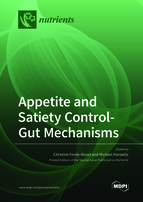Appetite and Satiety Control-Gut Mechanisms
A special issue of Nutrients (ISSN 2072-6643). This special issue belongs to the section "Nutrition and Metabolism".
Deadline for manuscript submissions: closed (15 January 2021) | Viewed by 131618
Special Issue Editors
Interests: appetite regulation in humans; gastrointestinal function; gut hormones; gastric emptying; GI motility; dietary nutrients; obesity
2. Endocrine and Metabolic Unit, Royal Adelaide Hospital, Adelaide, Australia
Interests: appetite regulation in humans; gastrointestinal function and glycaemic control in diabetes; gastric emptying; dietary nutrients; obesity
Special Issue Information
Dear Colleagues,
With the continued rise in the prevalence of obesity and its comorbidities, type 2 diabetes, and cardiovascular and hepatic disease, and the recognition that therapeutic options for both prevention and management are suboptimal, an improved understanding of the mechanisms that regulate appetite and energy intake is of pivotal importance.
Appetite and energy intake are modulated by a diverse range of factors. These include physiological mechanisms, such as acute changes in the release of gut hormones, slowing of gastric emptying, and elevations in circulating levels of metabolites, the physicochemical properties of food, and environmental influences.
This Special Issue will collate recent high-quality research in the field of appetite regulation, focussing on the investigation of gut-related mechanisms, including nutrient sensing, gut hormones, gastrointestinal motility, gut–brain communication, and roles of the vagus, diet, and the microbiome. Both original research articles and reviews spanning clinical and preclinical work are welcome.
Prof. Dr. Christine Feinle-Bisset
Prof. Michael Horowitz
Guest Editors
Manuscript Submission Information
Manuscripts should be submitted online at www.mdpi.com by registering and logging in to this website. Once you are registered, click here to go to the submission form. Manuscripts can be submitted until the deadline. All submissions that pass pre-check are peer-reviewed. Accepted papers will be published continuously in the journal (as soon as accepted) and will be listed together on the special issue website. Research articles, review articles as well as short communications are invited. For planned papers, a title and short abstract (about 100 words) can be sent to the Editorial Office for announcement on this website.
Submitted manuscripts should not have been published previously, nor be under consideration for publication elsewhere (except conference proceedings papers). All manuscripts are thoroughly refereed through a single-blind peer-review process. A guide for authors and other relevant information for submission of manuscripts is available on the Instructions for Authors page. Nutrients is an international peer-reviewed open access semimonthly journal published by MDPI.
Please visit the Instructions for Authors page before submitting a manuscript. The Article Processing Charge (APC) for publication in this open access journal is 2900 CHF (Swiss Francs). Submitted papers should be well formatted and use good English. Authors may use MDPI's English editing service prior to publication or during author revisions.
Keywords
- eating behaviour
- appetite
- food intake
- energy intake
- satiation/satiety
- gut mechanisms
- appetite-regulatory hormones
- gut hormones
- gut functions
- gastric emptying
- intestinal nutrient sensing
- dietary changes
- gut–brain communication
- gut microbiome
- human
- animal/preclinical
- obesity
- type 2 diabetes.








